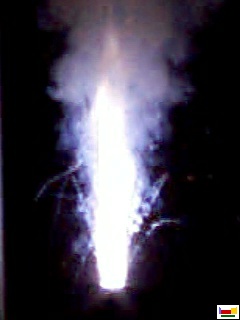Magnesium: the essentialsBrief description: magnesium is a grayish-white, fairly tough metal. Magnesium is the eighth most abundant element in the earth's crust although not found in it's elemental form. It is a Group 2 element (Group IIA in older labelling schemes). Group 2 elements are called alkaline earth metals. Magnesium metal burns with a very bright light. Magnesium is an important element for plant and animal life. Chlorophylls are porphyrins based upon magnesium. The adult human daily requirement of magnesium is about 0.3 g day-1.
Magnesium tarnishes slightly in air, and finely divided magnesium readily ignites upon heating in air and burns with a dazzling white flame. Normally magnesium is coated with a layer of oxide, MgO, that protects magnesium from air and water.
IsolationIsolation: magnesium can be made commercially by several processes and would not normally be made in the laboratory because of its ready availability. There are massive amounts of magnesium in seawater. This can be recovered as magnesium chloride, MgCl2 through reaction with calcium oxide, CaO. CaO + H2O → Ca2+ + 2OH- Mg2+ + 2OH- → Mg(OH)2 Mg(OH)2 + 2HCl → MgCl2 + 2H2O Electrolysis of hot molten MgCl2 affords magnesium as a liquid whih is poured off and chlorine gas. cathode: Mg2+(l) + 2e- → Mg anode: Cl-(l) → 1/2Cl2 (g) + e- The other methos used to produce magnesium is non electrolytic and involves dolomite, [MgCa(CO3)2], an important magnesium mineral. This is "calcined" by heating to form calcined dolomite, MgO.CaO, and this reacted with ferrosilicon alloy. 2[MgO.CaO] + FeSi → 2Mg + Ca2SiO4 + Fe The magnesium may be distilled out from this mixture of products. WebElements ShopWebElements now has an online shop at which you can buy periodic table posters, mugs, T-shirts, games, molecular models, and more. |
|||||||||
|
|





 Magnesium
Magnesium Magnésium
Magnésium Magnesium
Magnesium Magnesium
Magnesium Magnesio
Magnesio Magnesio
Magnesio Magnesium
Magnesium Magnésio
Magnésio